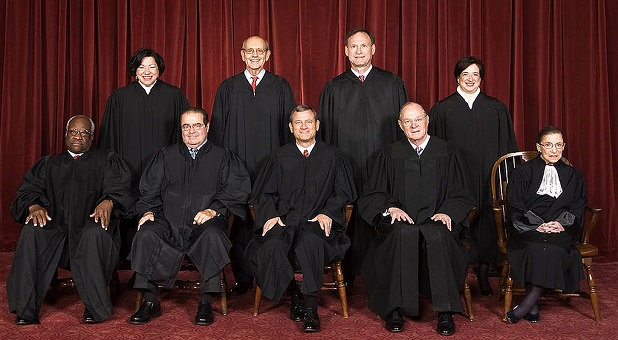The Answer for Judicial Activism: No More Lifetime Appointments
Democrats and Republicans alike have turned Supreme Court appointments into a partisan slugfest. No wonder: while the judiciary has long been described as the least dangerous branch of government, the court has become instead a continuing constitutional convention. Just five votes can turn the Constitution inside out. The latest Supreme Court term was seen as a shift to the left. The high court rewrote Obamacare to save the president’s landmark legislation to socialize American health care and completed a social revolution by nationalizing gay marriage. These decisions set off a flurry of promises from Republican Party presidential candidates to confront the judiciary. Extreme Measures Jeb Bush said he would only appoint judges “with a proven record of judicial restraint,” even though previous presidents claiming to do the same chose Anthony Kennedy, David Souter, and John Roberts, among many other conservative disappointments. Senator Ted Cruz, R-TX, called for judicial retention elections. Such a change at the federal level would require a constitutional amendment, though it would mimic the practices of some 20 states. Even more controversially, Cruz suggested that only those whose case was brought before the justices had to respect Supreme Court rulings. Extreme measures seem necessary because a simultaneously progressive and activist judiciary has joined the legislature and executive in forthrightly making public policy. Should Justices Serve for Life? The influence of judges has been magnified by their relative immunity from political pressure. Although the courts sometimes follow the election returns, in many cases — such as abortion and gay marriage — judicial decisions have short-circuited normal political discourse. That fact alone makes judicial appointments important. Their significance is magnified by judges’ life tenure. Lose the battle over filling a Supreme Court slot and you may suffer the consequences for decades. Gerald Ford’s unelected presidency merits little more than a historical footnote, but his Supreme Court legacy long persisted through Justice John Paul Stevens, a judicial ideologue hostile to liberty in most forms. Republicans going back to Dwight Eisenhower publicly lamented the evolution of their appointees, and every one of them made at least one choice that ultimately advanced a big-government agenda. Anthony Kennedy and John Roberts fill that role today. Lifetime tenure has other consequences. The appointment process is endlessly arbitrary, as judges hang on, irrespective of advancing age. Although instances of obvious infirmity are few — the last clear Supreme Court case was William O. Douglas, who served more than 36 years before retiring in 1975 — outcomes should not be affected by actuarial tables. A gerontocratic court differs dramatically from the society on behalf of which its members purport to speak. The lack of turnover also may deaden court debate, reinforcing established patterns of thinking.
Independence versus Accountability Life tenure is enshrined in the Constitution and rooted in history. The justification for lifetime appointment is to insulate the courts from transient political pressures. Some such protection is necessary if judges are to feel free to make unpopular decisions upholding the nation’s fundamental law. Yet, judicial independence does not require lack of accountability. Judges are supposed to play a limited though vital role: interpreting, not transforming, the law. The dichotomy of activism versus restraint is the wrong prism for viewing judges. They should be active in enforcing the law, striking down legislation, and vindicating rights when required by the Constitution. They should be restrained in substituting their policy preferences for those of elected representatives. When jurists violate this role, as do so many judges, they should be held accountable. Unfortunately, many of the proposed responses are more dangerous than the judges themselves. For instance, limiting court jurisdiction or impeaching errant jurists, oft proposed in the past, provides obvious opportunities for abuse. Worse is Cruz’s idea that most people should ignore the Supreme Court. Where government branches collide, someone must have a final say, or else the result will be enduring political conflict and limited legal legitimacy. Ignore the Court? More important, Cruz would presumably not want politicians to ignore court rulings with which he agreed. After all, as originally conceived, the judiciary was tasked with the critical role of holding the executive and legislative branches accountable, limiting their propensity to exceed their bounds and abuse the people. For instance, Alexander Hamilton imagined independent courts playing a “peculiarly essential” role to safeguard liberties and being an “excellent barrier to the encroachments and oppressions of the representative body.” Indeed, he contended, the judiciary would “guard the Constitution and the rights of individuals” from “the people themselves.” Thomas Jefferson argued that judges would provide a “legal check” on political majorities. James Madison, often viewed as the father of the Constitution, predicted that:
independent tribunals of justice will consider themselves in a peculiar manner the guardians of [Bill of Rights guarantees]; they will be an impenetrable bulwark against every assumption of power in the legislative or executive; they will be naturally led to resist every encroachment upon rights expressly stipulated for in the constitution by the declaration of rights.
Of course, all too often the judiciary fails to fulfill this role today. No less than the presidents and congressmen, judges have become avid advocates of statism. Jurists as well as politicians should be held accountable. Unreviewable power is always dangerous. Throw the Bums Out? Some 20 states have implemented Cruz’s second idea, of retention elections. Few judges are defenestrated, but on occasion, the results are dramatic. Three decades ago, California voters ousted three state supreme court jurists who had effectively repealed the death penalty. In 2010, Iowa voters defeated three state supreme court judges who ruled in favor of gay marriage. National judicial elections, however, would be far more problematic. Should the decision be made via national vote or by a majority of state votes? Moreover, it is hard to believe that Americans who today choose their president based on 30-second television spots would pay serious attention to esoteric legal issues and make the fine distinctions characteristic of legal and constitutional analysis. Worse, judicial votes might reinforce the reigning political consensus, allowing majorities to remove justices most prepared to enforce the constitution against those in power. Unfortunately, further politicizing the judiciary would be an uncertain means of counteracting the problem of a politicized judiciary. There is a better alternative. The Solution: Fixed Terms The Constitution should be amended to authorize fixed terms for federal judges. Perhaps one term of 10 or 12 years for Supreme Court justices, though Federalist Society founder Steve Calabresi suggested 18-year terms. Another option would be a renewable term of 6 or 8 years. Staggering terms would ensure every president at least a couple of appointments. Mixing short and long terms would expand diversity. Such an approach would offer several advantages. While every appointment would remain important, judicial nominations would no longer be as likely to become political Armageddon. The new justice’s service would be bounded with his exit from office already set, and another appointment would be due a couple of years later. Term limits also would ensure a steady transformation of the court’s membership. New additions at regular intervals would encourage intellectual as well as physical rejuvenation of the court. No longer would justices attempt to desperately hang on in order to outlast a president of another party. Law rather than health would determine the pace of judicial appointments. Most important, fixed terms would establish judicial accountability. Justices still would be independent, largely immune to political retaliation for their decisions. Thus, if so inclined, they still could “resist every encroachment upon rights expressly stipulated for in the constitution by the declaration of rights.” Nevertheless, abusive judges would no longer serve for life. Elective officials could reassert control over the court without destroying the judicial institution. There would be no court-packing, a la Franklin Delano Roosevelt, as transformation would take time, over two or three presidencies. The Supreme Court has become as consequential as the presidency in making public policy. Indeed, contrary to their originally envisioned role, judges have become as likely as politicians to push to expand state power and limit individual liberty. It is necessary to find a way to impose accountability while preserving independence. Appointing judges to fixed terms would simultaneously achieve both objectives. Doug Bandow is a senior fellow at the Cato Institute and the author of a number of books on economics and politics. He writes regularly on military non-interventionism. This essay was originally published by the Foundation for Economic Education.






































